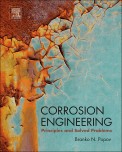 Book reviews
Book reviews-
Corrosion Engineering: Principles and Solved Problems
Publisher
: Elsevier B.V., Amsterdam
Title
: Corrosion Engineering: Principles and Solved Problems
Author Branko N. Popov Year of Publication
: 2015
Pages
: 794
ISBN
: 9780444627223
Reviewer
: Krishna B. Misra
Status
: Review Complete
The book comprises 15 chapters, preceded by an Acknowledgement and a Preface. At the end of the book, a Solution Guide for a reader to the set of problems given at the end of each chapter starting with chapter 2.
According to an estimate given in this book, corrosion in United States alone costs $ 276 billion in direct loss to the industry which is about 3.2 % of the US GDP. This does not include associated costs in indirect costs due to failures. Therefore, the importance of corrosion engineering cannot be underestimated. Corrosion is a leadingChapter 1
Evaluation of Corrosion
26 Pages
Chapter 2
Thermodynamics in the Electrochemical Reactions of Corrosion
64 Pages
Chapter 3
Electrochemical Kinetics of Corrosion
50 Pages
Chapter 4
Passivity
37 Pages
Chapter 5
Basics of Corrosion Measurements
57 Pages
Chapter 6
Galvanic Corrosion
49 Pages
Chapter 7
Pitting and Crevice Corrosion
37 Pages
Chapter 8
Hydrogen Permeation and Hydrogen-Induced Cracking
38 Pages
Chapter 9
Stress Corrosion Cracking
86 Pages
Chapter 10
Atmospheric Corrosion
30 Pages
Chapter 11
High-Temperature Corrosion
43 Pages
Chapter 12
Corrosion of Structural Concrete
32 Pages
Chapter 13
Organic Coatings
43 Pages
Chapter 14
Corrosion Inhibitors
17 Pages
Chapter 15
Cathodic Protection
39 Pages
Solution Guide (Chapter-wise starting with Chapter 2)
119 Pages
Index
16 Pages
Colour Plates
20 Pages
 factor of catastrophic failures in bridges, nuclear plants, aircrafts, chemical, petrochemical and construction industries. The author is Carolina Distinguished Professor and Director of the Centre for Electrochemical Engineering at the University of South Carolina (USC)in USA, where he established an internationally recognized research program in corrosion and electrochemical engineering and figures among the highly cited researcher for the year 2014.
factor of catastrophic failures in bridges, nuclear plants, aircrafts, chemical, petrochemical and construction industries. The author is Carolina Distinguished Professor and Director of the Centre for Electrochemical Engineering at the University of South Carolina (USC)in USA, where he established an internationally recognized research program in corrosion and electrochemical engineering and figures among the highly cited researcher for the year 2014.
This book is an outcome of the author’s experience of teaching corrosion engineering to undergraduate and graduate students and of his own extensive research in the area of corrosion engineering over several years. In fact, the book is an authoritative treatise on the subject. The utility of the book is enhanced by the sets of solved examples and case studies presented by the author. Starting with the presentation of theory of corrosion engineering and fundamentals of passivity, basics of corrosion measurements, this book discusses in depth various kinds of corrosions such as galvanic corrosion, stress corrosion, temperature and atmospheric corrosion, including high temperature corrosion. Inclusion of Hydrogen permeation and hydrogen-induced cracking increases the utility of the book.
The book also discusses at great length the practical corrosion protection strategies which would help a system designer in preventing corrosion. In fact the book is a complete resource book on corrosion engineering which a chemical engineer or metallurgist must consult before attempting to protect his systems against corrosion. In addition, a bibliography citing more than 1350 studies published in last 10 years enhances the usefulness of the book. Audience for this book naturally is expected to be chemical engineers, mechanical and civil engineers, materials scientists and energy engineers.This review has been published in Vol. 11, No. 5, September 2015 issue of the IJPE

